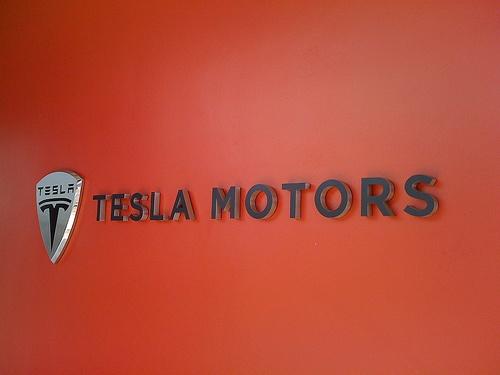Marks & Spencer wins Carbon Trust triple award


Marks & Spencer (M&S) has become the first retailer to receive the triple award of certification for achievements in carbon, water and waste reduction from the Carbon Trust.
Tom Delay, chief executive of the Carbon Trust, commented: “M&S has a well-deserved reputation as a leading business when it comes to sustainability. By achieving independent certification the Carbon Trust Standard for each of carbon, water and waste then M&S is able to demonstrate year-on-year progress in achieving its Plan A goals.”
Since the launch of Plan A, M&S’ much lauded eco and ethical programme, it has achieved zero waste to landfill and become a carbon neutral company. It has also reduced energy use in stores, offices and warehouses by 31% and reduced store refrigerant gas carbon emissions by 60%.
Tesla's 'Gigafactory' To Produce More Than Car Batteries


Last week, Tesla announced that it would build a new "Gigafactory" to produce lithium-ion batteries at a rate able to support the manufacture of 500,000 electric cars per year. By 2020, the plant will be capable of producing as many lithium-ion batteries as the entire world produced in 2013.
The Gigafactory, Tesla says, will support 6,500 jobs directly, and according to a post on the company's blog, the company expects that volume manufacturing of its mass-market vehicle will drive down the cost-per-kWh of its batteries by 30 percent in the first year.
The mass-market vehicle, yet to be released, will be designated the Model E. According to a report in TechCrunch, it will be 20 percent smaller than the current Model S, with a target range of 200 miles. While that's fewer than the maximum range of the Model S, it's ahead of any other pure EV currently on the market. Cheaper batteries may be crucial in cutting costs sufficiently to allow the company to produce the more affordable car, but the new factory also plays into more diverse plans for the company.
Last week, the San Francisco Chronicle reported that as well as supporting vehicle battery production, documents filed with the Securities and Exchange Commission detailed that some of the lithium-ion batteries will be used for "stationary storage applications;" that is, batteries for storing energy for use in homes, commercial sites and utilities.
This makes sense, since Elon Musk, as well as heading Tesla, is also the chairman of California-based Solar City, an installer of solar energy systems to homes and businesses with a national reach. The Chronicle reports that the market for grid-scale storage could reach $30 billion by 2022, and a Morgan Stanley report published recently, argues the company could seize a commanding role in the the energy storage industry. Evidently, the new factory is more forward-thinking than just meeting EV production goals.
In the meantime, the location of the Gigafactory has yet to be determined, though Tesla has announced it will be in one of four possible states: Nevada, Arizona, Texas or New Mexico. According to USA Today, these "finalists" were chosen because each has both the climate and terrain suited for Tesla's plan to power the factory largely with a sprawling farm of solar panels and wind turbines. The plant will need up to 1,000 acres, or close to 2 square miles.
USA Today reports that competition among the four states has set off a bidding war to try to attract Tesla's business, stating that incentives being offered could reach new heights--including $200 to $400 million for site infrastructure and worker job training, and $300 to $600 million in tax breaks.
The choice of the winning state could also set up an interesting opportunity for Tesla to leverage some marketing opportunities, too. Many states, have challenged the legality of Tesla's direct-to-customer sales model, whereby the company side-steps dealership involvement in the sales process. Lawsuits have been filed in many states based on existing automotive franchise laws, and Texas is one such state that has disallowed the company to sell to customers directly. USA Today suggests Tesla might demand the state change its laws to take dealer middlemen out of the equation as part of a winning deal.
But wherever the factory lands, it will be expensive. Tesla plans on selling $1.6 billion in bonds to help finance the plant; the company will invest $2 billion, while speculation exists that Tesla's existing battery partner, Panasonic, might pitch in another $1 billion as well.
Image Credit: Sam Felder
Follow me on Twitter: @PhilCovBlog
Mattel Missed a Big Opportunity with 'Entrepreneur Barbie'


Barbie recently started the latest of 150+ careers: Entrepreneur Barbie. It's a timely topic because female entrepreneurship has been growing exponentially in the past several years, but Mattel sticks to their formula Barbie and misses a great opportunity to branch out and really inspire young girls.
With Entrepreneur Barbie, Mattel had a chance to show more than one image of a female business owner--but stayed with generic Barbie. Mattel reported that Barbie sales have been steadily falling in recent years (Barbie revenue was down 40 percent in the U.S. in 2012), and this would have been a way to show that Barbie was adapting to a new reality, one where girls see more realistic role models. Many women who start their own businesses are older, experienced businesswomen, or moms with a unique idea, or both, along with a dozen other iterations besides a shiny, plastic businesswoman. The description of the doll gives no specifics about Barbie's business, except that she has all the latest toys (her business must be well-funded).
Mattel is ignoring many of the latest trends, including companies like GoldieBlox, a woman-owned business that encourages girls to learn engineering principles (STEM careers) and recently won a contest to have an ad in the Super Bowl, and Girls Will Be. This popular Kickstarter-funded company makes girls clothing that isn't "pink and sparkly" and whose latest line of shorts is generously cut, not "short-shorts" in response to parents and girls who are rejecting the skinny-fit, pink and tight lines of girls clothes available today.
Entrepreneur Barbie's release also coincides closely with Sheryl Sandberg's LeanIn.org and Getty Images' campaign to change the image of women entrepreneurs to be more empowering. Bloomberg Businessweek found that searches for "women in business" were turning up images of women massaging their male colleague, crawling under their desks in short skirts (for reasons unknown) and walking down an aisle of leering men, among others.
Now, searching for "female entrepreneur" or reviewing the Lean In Collection on Getty shows a wide variety of female-centric images of women that look creative and hardworking, not just sexy. One woman is in a hard hat doing inventory, another is in an apron, leaning over an ice chest full of fish, and many are in front of laptops, although not many seem to be so dressed up as Barbie, and they come in all shapes, sizes, ages and ethnicities. They are also featured with male colleagues in a more equitable manner.
Why does stock photography matter? Often, it is the way that companies find images to represent their business in ads, catalogs, annual reports and websites. Increasingly organizations are realizing that these images are not the face they want to put on their business, but good images of women in business (along with men) were hard to find. As Sandberg told AdWeek, "You can't be what you can't see. In an age where media are all around us, it is critical that images provide examples that both women and men can emulate."
Is it unfortunate that Barbie is not only clinging to its stagnant image, but taking things one step further by starring as Sports Illustrated's cover image for its swimsuit issue this month--doubling down on its unrealistic measurements and plastic visage. Sports Illustrated and Mattel stood by their choice despite widespread criticism.
Now, Entrepreneur Barbie hits the shelves. While some female entrepreneurs may well look this way, it is such a small part of the story, and Mattel fails to tell it. What would be great is if they released other versions of Entrepreneur Barbie (although they do have the same doll available in brunette and African American versions), or featured a tableau where an older version of Barbie sat behind a laptop (or did inventory or sorted fish) and Ken vacuumed and Barbie's child set the table. That would be something that would at least tell another version of the story.
Bio-Bean Coffee Conversion: Whole Bean Genius


Coffee is on the minds of many these days–coffee grounds, that is. And no wonder. Pondering the meaning of life over that cup of java naturally leads to pondering the values of sustainability and eco-claims for businesses (it does for me at least), and what’s a more sustainable, multipurpose ingredient than the dregs from our favorite brew?
After all, gardeners have been using coffee grounds to benefit their plants for eons. Housekeepers use them to clean their pots and tone up furniture scratches, and cooks use them to scour off the stain and smell of their favorite foods (and you thought that was all there was in the pot after you finished your morning brew).
But all of those uses won’t absorb the left over grounds found in say, London, England, where its plethora of coffeehouses produce more than 200,000 tons of filtered coffee grounds per year.
And that’s why both researchers and private companies have been so intent upon finding ways to use those grounds in mass production. The University of Nevada (Reno) experimented with extracting and converting the coffee oils to biofuels through transesterification in 2008. Converting spent coffee grounds to burnable pellets that can be used to fuel boilers and pellet stoves has already been done as well. Coffee grounds were already in use as a burnable supply for boilers in 2009 when entrepreneur Paul Kalenian was trucking his coffee grounds to a steam-fueled plant for use.
But using these two technologies in synchrony to take the benefit of both the coffee bean’s oils and its woody, burnable pulp has been a challenge for some years–and interestingly, one that would take an architecture graduate and a green entrepreneur to figure out.
Arthur Kay and Benjamin Harriman are the brains behind Bio-Bean, a company that aims to put London’s bounty of coffee grounds to good, recyclable use. Their company, which is still in nascent stages, has already received some thumbs-up, including a significant one from Mayor Boris Johnson, who wants London’s young entrepreneurs to step forward in support of green business.
Bio-Bean plans include a pickup service for London's coffeehouses and roasters, that will then allow it to extract the oils from the grounds, convert them to biodiesel, and then produce burnable pellets with the remainder of the bean. Both products can be easily used in the U.K., since London’s buses all run on biodiesel and the pellets can be used for heating fuel.
Their idea also gets around one other challenge: It diminishes the use of food crops for diesel production.
Bio-Bean hopes to have its factory up and running in the London area by the end of the year.
http://vimeo.com/biobean/elevator-pitch
Image: Alex Upshur
Kiva and Vittana Crowdfund Student Loans in the Developing World


It is no secret that education is the surest route to a better life, but for tens of thousands of low-income students in developing nations, high costs mean that access to it continues to be the stuff of fantasy. Student loans are notoriously hard to come by outside of the U.S. and Europe, largely due to the fact that banks have no track record of repayments that can be used to assess risk, and students generally don’t have collateral or a credit history to prove that they can pay back loans.
The answer to this classic "chicken-or-the-egg" problem could lay with crowdfunding, which not only presents an opportunity to get tuition loans to students who need them, but also to build a “track record of repayment” that will encourage financial institutions to offer more loans to students.
Vittana.org uses crowdfunded student loans to help people in regions where higher education is out of reach but job opportunities exist for graduates of colleges and technical and vocational schools. The nonprofit partners with local organizations and micro-finance institutions (MFIs) to create tuition loan programs for students who are close to graduation but need money to pay final tuition in order to graduate. Loans average $750, and a repayment rate of 99 percent, which shows that students will pay back their loans if given the opportunity. As students continue to successfully repay their loans, they are creating that repayment history and opening the door for millions of other students in the future.
Beginning on April 2, all student loans sourced by Vittana.org will be posted on Kiva’s website for crowdfunding rather than on the Vittana website. Visitors will be able to browse through the stories and profiles of students and select one they want to support with a loan of $25 or more.
Kiva connects millions of people around the world through lending to alleviate poverty in areas lacking access to traditional banking systems. With as little as a $25 loan, anyone can help a borrower to start or grow a business, go to school, access clean energy and realize his or her potential. Since its inception in 2005, Kiva says more than 1 million people have used its crowdfunding platform to lend more than $500 million in loans to over 1 million borrowers, with a 98 percent repayment rate.
In 2014 Kiva and Vittana expect to help 20,000 students access crowdfunded tuition loans in Latin America, Southeast Asia and Africa. The partnership will allow Vittana to focus its efforts on expanding technical assistance for both student applicants and MFIs wanting to create loans tailored for student needs.
"Access to education sits at the crux of poverty and economic development,” said Premal Shah, co-founder and president of Kiva. “With Kiva and Vittana working together, we can help to break the cycle of generational poverty and expand access to higher education by proving to financial markets that students can and do pay back loans.”
According to Vittana’s 2014 comprehensive impact report, among Vittana.org students surveyed, 85 percent were employed a year after graduation. Students also were able to increase their incomes by an average of 93 percent. The collective increased earnings of 20,000 students is more than $65 million per year, helping lift themselves, their families and their communities out of poverty.
“Through education we can empower the youth of the world to alleviate poverty, gender inequality, violence, malnutrition, pollution and many of the other battles constantly faced around the world–nourishing a virtuous cycle of change,” said Robin Wolaner, CEO of Vittana.
Just as Benjamin Franklin once said: “An investment in knowledge always pays the best interest.”
Image credit: Kiva.org
Based in San Francisco, Mike Hower is a writer, thinker and strategic communicator that revels in driving the conversation at the intersection of sustainability, social entrepreneurship, tech, politics and law. He has cultivated diverse experience working for the United States Congress in Washington, D.C., helping Silicon Valley startups with strategic communications and teaching in South America. Connect with him on LinkedIn or follow him on Twitter (@mikehower)
Chinese Man Sues Government Over Smog


China is infamous for its dangerously high levels of air pollution, and now one man is suing the government for failing to reduce the toxic smog.
Li Guixin, who lives in a major industrial region of northern China surrounding Beijing, filed a complaint with a district court, urging the city’s environmental department to improve its efforts to control air pollution, Reuters reported last week. Li is the first person to bring such a lawsuit forward against the government.
Li also requested 10,000 yuan ($1,635) in compensation for face masks, an air filter and a treadmill to exercise indoors in December when air quality is particularly bad, according to Bloomberg News.
"The reason that I'm proposing administrative compensation is to let every citizen see that amid this haze, we're the real victims," Li told the state-run Yanzhao Metropolis Daily, the BBC reported. "Besides the threat to our health, we've also suffered economic losses, and these losses should be borne by the government and the environmental departments because the government is the recipient of corporate taxes: It is a beneficiary."
The smog levels in Li’s hometown of Shijiazhuang in Hebei province regularly top levels considered to be hazardous by the World Health Organization, according to the BBC. China’s Ministry of Environmental Protection ranked Shijiazhuang as one of the 10 cities with the worst air pollution in the country, Bloomberg News reported.
“Li Guixin couldn’t take a walk or run like the past as air quality worsened, and he also has to wear a mask now when he goes out,” Li’s attorney Wu Yufen told Bloomberg News. “His case is relevant for everyone in our city.”
The Chinese government said in September that it planned to curb air pollution by closing outdated steel and cement facilities and reducing its use of coal in Hebei province, Reuters reported.
While it is unclear if Li’s case will even make it to trial (the BBC noted that the suit has already been rejected by several high courts), it is an interesting example of the Chinese government being forced to face the externalities of its recent economic growth. Will the government be required to compensate Li for health effects caused by the air pollution it failed to regulate, or should the companies with the factories actually spewing out the smog be forced to pay?
Li’s grievance with country’s air pollution also represents a growing concern among average Chinese citizens about the environmental cost the country’s economic growth has brought. Much like the environmental protests in the U.S. in the late ‘60s that led to the formation of the Environmental Protection Agency and landmark legislation like the Clean Air and Water Acts, perhaps Li’s lawsuit is a baby step towards building a grassroots movement that changes the way China regulates and manages its environmental resources.
Image credit: Flickr/woggle
Passionate about both writing and sustainability, Alexis Petru is freelance journalist based in the San Francisco Bay Area whose work has appeared on Earth911, Huffington Post and Patch.com. Prior to working as a writer, she coordinated environmental programs for Bay Area cities and counties. Connect with Alexis on Twitter at @alexispetru
Sustainability and Catastrophic Risk: What Business Leaders Can Learn from BP


By Jay Apt
It is natural for our optimistic and energetic MBA students to look at the upside of decisions, and to maximize the returns on their firm’s investment in the minimum time. But that isn’t always a strategy for sustainability, either for the firm or for the planet.
Imagine that you are the leader of the largest railway signal-and-control company in the world’s fastest-growing economy. Your firm supplies its technology to more than 20 countries. Your market share in those countries far eclipses your competitors’ shares combined, and your investment of profits into reducing manufacturing costs will keep it that way. Life is good, and you are happy that you have balanced profit maximizing with mitigating business risks by investing in meeting the needs of your customers. You are grooming your daughter to take over the business, and look forward to the third generation coming along shortly.
Then a low-probability event of enormous consequence happens. Lightning strikes a high-speed rail line, and wrong signals are flashed. One high-speed train crashes into the rear of another on a bridge. Forty people are killed and 191 injured. A Cabinet investigation receives worldwide coverage. The investigation finds flawed development of the signaling equipment, poor quality and slipshod inspections by safety professionals. Your dreams of a generations-long business lie with the wreckage of the ruined trains.
Catastrophic risk can end corporate life. Catastrophic risks are unanticipated losses or damage that cripple an organization and often lead to a survival mode. BP systematically underestimated physical risks, costing the company $20 billion and the CEO his job. Physical risk management failures forced the Johns-Manville company into Chapter 11 bankruptcy for five years. A toxic gas leak at a Union Carbide plant killed 14,000 people in India, and the company nearly repeated the disaster in West Virginia within a year; it was forced to sell off profitable subsidiaries to survive a hostile-takeover attempt when the disasters drove down its stock price. On the other hand, one man in China turned around that nation’s once-dismal airline safety record.
Since 2007, I’ve been teaching our Tepper MBA students a course in Catastrophic Risk Analysis and Management. What is the connection between sustainability and catastrophic risk? The core concept is understanding, analyzing and managing high-consequence events (that may be of low probability) in the presence of irreducible uncertainty.
These uncertainties can be about the types of events or about modes of the failure chain. But the largest uncertainty is one internal to the firm and to its leaders. It is a question of time scale. Potentially catastrophic events can be ignored for a while, but if the firm plans to be in business for a long time, managing these sorts of events must be considered.
It is this very question of time scale that is critical to the question of sustainability, whether of the firm or of our planet.
While only one of the course modules is on a topic that is explicitly related to “sustainability," greenhouse gas emissions, every module deals with developing a culture that considers long-term risks. Those are the low-probability events that can rock a company to its foundations.
The Tepper School of Business attracts very quantitatively-inclined students. Our MBA students leave the course with five core lessons:
- Students learn how to identify and quantify physical risks in real-world problems.
- They are trained to structure their thinking about physical risks.
- They are familiarized with risk models and tools that include stock-and-flow analysis, toxicology and epidemiology (and the good and bad points of each), probabilistic risk analysis including Monte Carlo analysis, event trees and fault trees, benefit-cost analysis, and decision analysis.
- Students are exposed to practical examples of risk perception and risk communication.
- We leave the students with examples of both excellent and poor leadership in physical risk management.
Graphically, the course structure looks something like this:
One of the first class of models introduced in the course are stock-and-flow models. The MBA students readily understand that if income exceeds expenses (both are flows of cash) that the bank balance (a stock) will increase. The initial example used is the buildup of Radon gas in homes constructed in certain regions of the U.S. The flows are the leakage of Radon into and out of the home, and the stock is the concentration in the living spaces.
You could be invited to that home for a dinner party and not appreciably increase your risk of lung cancer. But if you lived there for 40 years and the concentration was high enough, it would be a different story. Time scales matter.
Similarly, the risk to firms due to greenhouse gas concentration depends on time scale and concentration. The flows here are the emissions of CO2 and other greenhouse gases and their natural absorption sinks, while the stock is the concentration in the atmosphere. Like a bathtub with more water flowing in than is leaving through the drain, the level of greenhouse gases in the air will rise if emissions exceed the natural sinks.
Time scales in this problem are of two types. First, CO2 and most other greenhouse gases are not like conventional pollutants that leave the air in days or weeks. Most of a ton of CO2 that is emitted today will be in the air in our great-grandchildren’s day. Second, there is very little harm to those of us living today from the greenhouse. Controlling emissions requires short-term discipline today so that people living well after we are gone can benefit. Some firms understand this well. Bloomberg News reported in December 2013 that Exxon Mobil, Royal Dutch Shell, BP, and Total are all basing plans for future capital investments on the assumption that they will have to pay for carbon dioxide emissions at a rate of up to $60 per metric ton.
The idea that a firm must take the long view has been largely out of favor in recent years. While my course acknowledges the arguments for short-term profit maximization, I also want the students to leave with an understanding that ignoring the low-probability, high-consequence events has been catastrophic for firms. True sustainability requires the discipline of putting resources into mitigating the chances of catastrophic events even at the risk of lower short-term profit. There are no correct answers, but by giving tomorrow’s business leaders examples of both good and poor decisions this course has been successful in making sustainability part of the conversation.
Image credit: Flickr/Green Fire Productions
Jay Apt is a Professor of Technology at the Carnegie Mellon Tepper School of Business and director of the Carnegie Mellon Electricity Industry Center.
Extended Power Outage Tests High-Performance House


My family experienced a five-day power outage last December after a Maine ice storm. The temperature of our neighbor's house dropped to near freezing after one night. Despite having below freezing temperatures, even subzero weather, our house remained pretty comfortable. The indoor temperature dropped by only 2 degrees daily, with no supplemental heat. While neighbors scrambled to hook up generators and space heaters to keep the pipes from freezing, we knew our house wouldn't freeze. What is our secret?
We live in a house where the design was guided by the Passive House Standard at Belfast Cohousing & Ecovillage. "Build it nice and tight, face it to the south, not towards the road, and put most of your glass on the south," explains GO Logic foreman John White. GO Logic, the builder of our house has designed and constructed two Passive House-certified homes in Maine.
The solar orientation and south-facing windows make a noticeable difference on sunny days. During the only sunny day of the outage, the indoor temperature in our home increased by 7 degrees. Even with the temperature below zero outside, our indoor temperature will increase by 5 to 10 degrees Fahrenheit throughout the course of the day. With a solar system, the homes can be near net-zero, meaning that the solar array can generate as much as the house consumes over the course of a year.
On sunny winter days, our home can easily gain 10 degrees from the sun alone. Because the angle of the sun is lower in the winter, the sunlight streams in. During the summer, the sun is higher in the sky and doesn't heat the space as much. Although the builder, GO Logic, believes the house meets the Passive House Standard, it has not been certified.
Passive House Standard for an energy-efficient home
This standard ensures houses meet a set of criteria for space-heating energy demand, primary energy demand and airtightness. GO Logic uses a blower door test to ensure the house performs to the Passive House Standard of less than or equal to 0.6 ACH at 50 Pascal pressure. That means that there would be fewer than 0.6 air-changes per hour in the house with a 50 Pascal pressure, which is five times the pressure our house is likely to experience on a cold winter day.
Passive House Standard is popular in Europe, where 15,000 homes have been constructed in the last 10 years. As is often the case with energy efficiency, the Passive House Standard has been much slower to catch on in the U.S. However, it has furthered the green building industry by quantifying the impact of energy-efficient building materials.
"The people at Passive House took [energy efficiency construction] ideas and were much more scientific about the physics of how buildings work," says Alan Gibson, a principal of GO Logic. "It is revolutionary in that it has spawned a new way of thinking around high performance buildings.
"The biggest thing they developed was the energy model spreadsheet that determines how much energy a building gains or loses. It’s all based on physics and math.You have a section of wall with certain properties and materials, and you can tell how much heat is going to move through that wall over time. If you put that all together and determine every way a building can gain or loose energy, you create a comprehensive model for how a building is going to perform."
Gibson believes that quantifying the properties of energy efficient building materials helps boost the market for these materials. "If you have a triple-glazed window and you compare it to a double-glazed window, you can quantify the difference in durability, comfort and moisture," explains Gibson. "All of a sudden, people wanted more triple-glazed windows, so the industry responded by producing more. When supply increases, they become cheaper."
Indoor air quality
"I think the Heat Recovery Ventilation (HRV) system is what revolutionized these houses," says Brian Hughes, a carpenter for GO Logic. "People have been building super-tight, insulated houses since the 1950s. The problem was that the air quality wasn’t good and people didn’t try having a super-tight buildings again until they figured out that with the heat exchanger, you can use a tiny bit of electricity and have really high air quality."
Our house has a Zehnder HRV system, which brings in filtered outside air and captures heat from stale indoor air before it leaves our house. Airtight homes need fresh air to ensure high indoor air quality and avoid humidity and mold issues. HRV systems are an energy-efficient solution that ensure excellent indoor air quality, while capturing up to 90 percent of the heat.
"There is the pocketbook savings [associated with a high-performance house], but there is also the social aspect of it too--making a conscious choice to live in a more sustainable house," adds White. "We are not conditioned to think that way. We are conditioned to think it’s private property and I can do what I want, as long as I’m not breaking the law. If gas is cheap, why would I care how much I use?"
Image Credit: Belfast Cohousing & Ecovillage
Sarah Lozanova is a regular contributor to environmental and energy publications and websites, including Mother Earth Living, Green Building & Design, Triple Pundit, Urban Farm, and Solar Today. Her experience includes work with small-scale solar energy installations and utility-scale wind farms. She earned an MBA in sustainable management from the Presidio Graduate School and she resides in Belfast Cohousing & Ecovillage in Midcoast Maine with her husband and two children.
Pinsent Masons takes up gender balance challenge


International law firm Pinsent Masons has launched 'Project Sky', a programme aimed at achieving an improved gender balance in the firm's partnership and senior leadership team by removing any barriers to the progression of women to the highest levels within the business.
Project Sky, which is being led by employment partner Linda Jones, will set in train a number of initiatives with the ultimate aim of ensuring that women will comprise 30% of the firm's partnership, with a first milestone of reaching 25% by 1 May 2018.
The project will ensure that over time Pinsent Masons improves the balance of male and female representation in its partnership while making certain the firm's policies and working practices encourage and support talent across the entire business irrespective of gender.
The launch of Project Sky follows consultation with a significant number of staff at the firm on the issue in conjunction with Female Breadwinners, a leading consultancy specialising in gender issues. It will involve a number of initiatives to promote: more transparent career development; greater accessibility to flexible or agile working; more structured support around parental leave and training to help identify and address subconscious bias.
Practice group heads have also been asked to consider whether the gender balance of shortlists for promotion to Partner, Legal Director and Senior Associate positions reflect the composition of their teams.
Linda Jones, a Partner in the Employment practice and leader of Project Sky, commented: "Currently more than 20% of the Pinsent Masons partnership is female while two out of nine people on our Board are women, benchmarking well against comparable firms in the professional services sector. However, around 70% of the lawyers coming into the business are female while the proportion of women in partnership is fairly static. If we are to properly utilise that talent changes are required. The steps we are taking are aimed at improving our gender balance at senior levels but will ultimately mean better working practices for all our staff."
Apple CEO Tim Cook Tells Climate Deniers to Take a Hike


Tim Cook, Apple's CEO and successor to Steve Jobs, is generally known as a man who, unlike his predecessor, has a cool head and does not let his emotions influence his decisions or his behavior on the job. But that is apparently not the case when it comes to global warming. Nothing seems to get him steamed up more than a group of climate deniers, like the group that recently attended Apple's annual shareholder meeting last Friday.
In attendance were representatives from the National Center for Public Policy Research (NPCCR), a self described “conservative think tank and policy institute,” that issued a statement before the meeting suggesting that the company renounce any environmentally-based activities that don't contribute directly to the bottom line.
The proposal, which was submitted by NCPPR General Counsel Justin Danhof, said: "We object to increased government control over company products and operations, and likewise mandatory environmental standards. This is something [Apple] should be actively fighting, not preparing surrender."
Danhof went so far as to suggest that this proposal be taken up as a pledge to be voted on by shareholders in the meeting. The proposal was voted on and soundly rejected, but not before Cook took the opportunity to comment. "We do a lot of things for reasons besides profit motive," he said. "We want to leave the world better than we found it."
Those objecting to the company's principled stand on the environment, said Cook, were welcome “to get out of the stock.”
Danhof was quick to issue a response on the NCPPR website.
"Mr. Cook made it very clear to me that if I, or any other investor, was more concerned with return on investment than reducing carbon dioxide emissions, my investment is no longer welcome at Apple,” Danhof said.
Danhof's suggestion to amend “Apple's corporate documents to indicate that the company would not pursue environmental initiatives that [don't] have some sort of reasonable return on investment--similar to the concession the National Center recently received from General Electric,” was “greeted by boos and hisses from the Al Gore contingency in the room.”
Danhof summed the situation up as follows: “Apple is as obsessed with the theory of so-called climate change as its board member Al Gore is. The company's CEO fervently wants investors who care more about return on investments than reducing CO2 emissions to no longer invest in Apple. Maybe they should take him up on that advice."
Of course, this shows nothing of the kind. What it does show is that executives like Tim Cook can now safely make statements like this, recognizing the extent that climate change deniers like Mr. Danhof are becoming increasingly marginalized. They no longer represent anything resembling a majority of Americans and are instead increasingly recognized as a fringe element, clinging tenaciously to narrow self-interests, completely out of touch with reality at a time of global crisis.
This outburst from La-La Land occurred on the same day that a joint document from the National Academy of Science and the United Kingdom's Royal Society came out, stating that these top-ranked scientists are more certain than ever the human role in climate change is substantial and real. The document states that: “Climate change is happening. We see it in temperature, we see it in the melting ice, and we see it in sea-level rise.”
Meanwhile conservatives in Mr. Danhof's camp have found themselves really stretching to contort the news to spinoff statements like, “ObamaCare is causing a catastrophic change to our health care climate and Harry Reid is denying it. Denier!” in a somewhat desperate attempt to remain relevant in yet another losing battle.
Image courtesy of Apple
RP Siegel, PE, is an inventor, consultant and author. He co-wrote the eco-thriller Vapor Trails, the first in a series covering the human side of various sustainability issues including energy, food, and water in an exciting and entertaining format. Now available on Kindle.
Follow RP Siegel on Twitter.